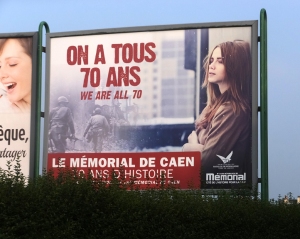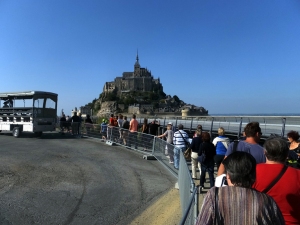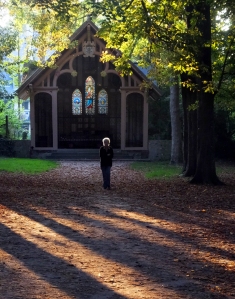Tags
American Cemetery, Atlantic Wall, Battle of Normandy, Bayeux, Bayeux Tapestry, Broadway Sims, Colleville-sur-Mer, D-Day, Erik Satie, Eugène Boudin, France, Granville, Honfleur, Impression: Sunrise, Joan of Arc, Les Maisons Satie, Monet, Mont Saint-Michel, Normandy, Omaha Beach, Path of Remembrance, Pegasus Bridge, Point du Hoc, Port Winston, Reporters Without Borders, Saint Leonard, World War II
Hello traveling companions,
After Paris, we rented a car and set out for Normandy to visit some of the most anticipated places on our itinerary: Bayeux, Mont Saint-Michel, Honfleur, and the D-Day beaches and memorials.
Bayeux was our base for exploring the sites of World War II’s D-Day invasion and the Battle of Normandy. It is also a short drive from Mont Saint-Michel, the historic abbey, monastery and village perched high on a rocky outcrop in the English Channel.
Honfleur was on the itinerary because it’s the birthplace of Impressionist art. We wanted to see the legendary light and the quaint harbor that inspired young Claude Monet to take such a radical new approach to painting.
Normandy was also a bit of a back-to-roots visit. My mother’s maiden name is Sage. The Sages likely came to England in the wave of settlers from continental Europe who traveled through Normandy and crossed the Channel to England as part of the Norman conquest in the 11th century.
(Note: Click a picture to see it larger, then click your back button to return to the blog.)
Bayeux
In addition to being our base for exploring Normandy, Bayeux has its own unique charms.

As in many European towns, a church or cathedral provides a convenient orientation point. The spires of Cathedrale Notre Dame de Bayeux are the first thing travelers see when approaching the town.

We ate tasty crepes in the Pomme Cannelle, a little sidewalk cafe next to the cathedral, recommended by European travel guru Rick Steves.

Bayeux’s main “claim to fame” is the Bayeux Tapestry. This remarkably preserved, 230-foot-long embroidery dates from the 11th or 12th century. The exact origin of the work is uncertain.

In comic-book-like panels, the Tapestry tells the story of the Norman invasion of England in 1066. The Duke of Normandy, then William the Bastard, prevailed over Harold in the Battle of Hastings. He has been known ever since as William the Conqueror. The history of western civilization was changed forever.

Bayeux is also home to the “Path of Remembrance,” a memorial garden created by Reporters Without Borders and the town of Bayeux. A marble panel for each year since 1944 lists the names of war correspondents who were killed that year. It is a moving and unusual memorial.

Bayeux is the site of the British military cemetery, a D-day museum, and many other reminders of the Battle of Normandy. More on that later is this post.
Mont Saint-Michel

Visitors to Mont Saint-Michel see it first from miles away as a small mountain looming above a coastal plain — some of the flattest terrain in France. This is a telephoto view from the visitors parking lot a mile-and-a-half from the island.

It’s hard to photograph the structure from within it. A statue of the Archangel Saint Michael sits far atop the lofty central spire.

Interesting details await around every turn, such as this statute of Joan of Arc at the entrance to a chapel. Joan believed that the Archangel Michael (Saint Michel), in a vision, urged her to liberate France.

It was low tide when we visited. At high tide Mont Saint-Michel is completely surrounded by water. A helicopter circles the area when the low tide starts to turn, looking for pilgrims making their way across the flats on foot. It is said that the tide comes in “like a galloping horse.”

To illustrate the magnitude of the tides, this is low-tide at Granville harbor, on the same bay as Mont Saint-Michel. We stopped at Granville on the way.
Honfleur
Both as a lover of Impressionist paintings and as a photographer, I went to Honfleur looking for Monet’s light.

This is the harbor where Monet created “Impression: Sunrise,” the painting that rocked the art world and gave the new movement it’s name.

I saw the light at different times of day play with the colors and shapes in the harbor, creating something new each time.

Many buildings in Honfleur are tall and skinny because the authorities created a tax structure based on the width of the buildings.

I can’t be sure I was seeing what Monet saw, but there was something unique about the pictures I was getting.

The lines and angles of the buildings are not quite square, giving many of them the look of a hand-drawn illustration in a storybook.

This shot was taken from a high vantage point over the town. The white church on the right is Saint Leonard’s. We were staying in a quaint flat on Rue Saint Leonard, near the church. A soundtrack of Leonard Cohen songs ran through my mind during our stay.

Art is everywhere in Honfleur. This metal sculpture was outside a gallery. I can’t resist a selfie when I see my reflection!

Honfleur’s Les Maisons Satie pays tribute to avant-garde musician and composer Erik Satie. He was born in Honfleur in 1866.

Using personal headphones, stories from the composer’s life, accompanied by Satie’s music, are automatically cued as the visitor moves through multiple rooms. Many of the stations are interactive. It is an interesting, fun, and enlightening experience.

The Musée Eugène Boudin is dedicated to the Honfleur artist who first urged young Claude Monet to get out of the studio and paint what he sees in the world around him. The museum houses paintings by Boudin and by later artists who painted in and around Honfleur.

Honfleur is on the English Channel at the mouth of the Seine. Across the river is the industrial seaport of Le Havre, which eclipsed Honfleur as a harbor and allowed Honfleur to remain largely as it was in the 19th century. For that I am grateful.
D-Day and the Liberation of Europe
This trip was a pilgrimage of sorts. Both our fathers served in the Second World War. If there was ever a “good war,” that was one. Hitler unleashed a regime of horror that had to be ended. We wanted to see what remains of it firsthand, and in some small way to honor the millions of ordinary people, soldiers and civilians, who sacrificed and suffered there. We had visited WWII museums and memorials all over France and in Amsterdam, but in Normandy we found the actual tools, effects, and scars of the war, still in place.

All over Normandy, memories of the war are kept alive by artifacts that remain to this day, such as this part of the artificial harbor assembled in the days following D-Day.

We visited Point du Hoc on the English Channel in Normandy. On D-Day, U.S. Army Rangers had to scale these cliffs under fire. Their mission was to take out a German observation post and gun battery.

Inside one German bunker is a memorial listing the names of Rangers killed in the invasion and the Battle of Normandy.

The Nazis had created the “Atlantic Wall” to make any attempt at invasion very costly. This is what remains of a bunker overlooking Omaha Beach.

Omaha Beach was the site of some of the most courageous and costly actions by American troops. They had to take out the German positions on those cliffs. More than 3,600 Americans were killed or wounded on this beach during the initial assault. The movie “Saving Private Ryan” begins here.

These are remains of Port Winston, the artificial harbor in the English Channel, assembled immediately after the invasion.

This is the beautiful and solemn American Cemetery overlooking the English Channel in Colleville-sur-Mer, Normandy, France. It is the final resting place for 9,387 Americans who died on D-Day and in the subsequent Battle of Normandy.

One is easily moved to tears at this powerful site. Every American who can should come here to honor the young heroes who died in the liberation of Europe.

Every Cross or Star of David marks the grave of an ordinary American who made an extraordinary sacrifice. This is the grave of Broadway Sims, from Tennessee. His name made me want to know his story, and a reader of this blog responded, so CLICK THE PHOTO TO LEARN MORE ABOUT BROADWAY SIMS. A website about him will open in a new window.

It wasn’t just Americans who are honored in Normandy. This is the British Cemetery in Bayeux. In a supreme irony, nearly 1,000 years after the Norman conquest of England was launched from this coast, British soldiers returned here to help liberate France.

Pegasus Bridge, site of the first casualties on D-Day. It is no longer in use but has been reassembled near the original site and restored as a memorial. The British squadron that captured and held this critical bridge had landed silently in three 30-man gliders and took the Nazis by surprise. After the war the bridge was renamed “Pegasus” because that was the insignia on their uniforms. The flags of every nation that participated in the D-Day invasion are flown.

2014 was the 70th anniversary of D-Day. All over Normandy are signs, billboards, posters, and drawings in shop windows commemorating the event, in addition to permanent memorials.
The gratitude of the French for their liberation, however painful it was, is still alive. On the way to Mont Saint-Michel we came upon another German defensive bunker overlooking the harbor in Granville. Like the others, it was left in place as a permanent memorial and reminder. We wandered around it, talking. A man about my age must have overheard and recognized us as Americans. He approached and said something to me in French, most of which which I did not understand. We had an awkward non-conversation, neither of us understanding much of the other’s language. I talked about my great sympathy for the people of Europe who suffered so in WWII. We in America have never experienced such widespread devastation and day-to-day horror inflicted by a foreign force on our own soil. Then he said to me, in accented English, “America good.” I said in return, “France good.” I extended my hand to shake his and he took it in friendship.

















Great photos! Sounds like wonderful places!
LikeLike
Thanks, Calvin!
LikeLike
what a fabulous entry! your photographs and words are so rich – thank you. Yes, I see the magic of the light. I’ve not been to any of these places and your photos make me want to go – and feel as if I’ve almost been there. big hugs to Sarah – so glad you two are having this adventure.
LikeLike
Thank you Charlie for sharing these beautiful images, your travel story and the story of Normandy and the surrounding area. I am verklempt (yiddish for choked with emotion). Your words and images are the next best thing to being there.
LikeLike
Thanks Julie! It is very gratifying to hear comments like yours. Charlie
LikeLike
Thank you, Linda! Big hugs back to you, and thanks for coming along with us. Sarah
LikeLike
I’m thrilled to see these fantastic pictures! Thanks for sharing. Some of the views are exactly what I took pictures of long ago.
LikeLike
Wow, Ellen, so happy to know you’re reading the blog! Thanks so much for reading and commenting. We’re extra happy to have you along with us. Only wish Mom could be too. Much love, Sarah
LikeLike
Merci Charli, my fingers have no words good enough to respond to your groooviness.
LikeLike
Avec plaisir, your Blueness.
LikeLike
I came across your blog while my student and I were completing research on a silent hero from Tennessee who made the ultimate sacrifice at Normandy. It just so happens that we chose to research and honor Technician 5th Class Broadway Valentine Sims, as part of a program called the Normandy Institute. The institute is a part of National History Day. My student and I just got back from visiting Normandy and my student is in the process of building a website dedicated to Broadway and preserving his story. If you are truly interested in Broadway’s story, we would be happy to share our website with you upon its completion.
LikeLike
Please keep me updated! And yan use my photo, with credit
LikeLike
My student is currently building a website on Broadway. I will share the link when he finishes it. Thanks!
LikeLike
I mean YES use my photo, with credit
LikeLike
Here is the web address for my students website on Broadway Sims.
http://84404564.weebly.com
LikeLike
Thank you! Very interesting web site. I will link to it on my site. Charlie
LikeLike